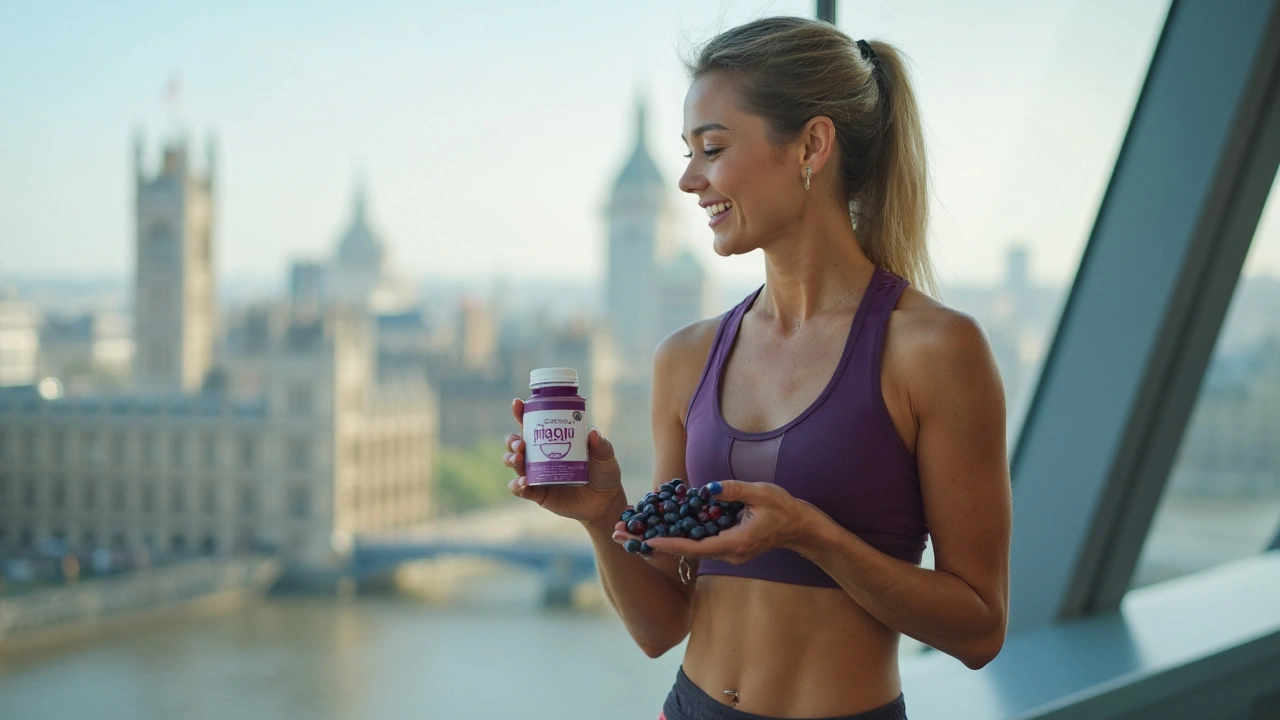
You’ve probably noticed maqui berry supplements popping up all over your feed and health websites. It’s not just hype—this small, deep purple berry from Patagonia has quickly become a go-to in the wellness world. In fact, it’s getting compared to blueberries and acai for its crazy-high antioxidant levels.
People keep asking: Does maqui actually work, or is it just the latest trend set to fizzle out? That’s a fair question, especially when these supplements aren’t exactly cheap and the claims sound almost too good to be true. If you’re thinking about giving maqui a shot, you’ll want to know what’s in it, who’s really benefiting, and—let’s be blunt—what’s just marketing talk.
Before spending your money or switching up your morning smoothie, get clear on how maqui works, what real research says (not just what Insta influencers claim), and if there are any red flags you should watch out for. There’s a lot of buzz, but there are also some things you should know to actually get value from this supposed super berry.
- Maqui 101: What Is It and Where Did It Come From?
- Why Is Maqui Suddenly Everywhere?
- What Science Really Says About Maqui’s Health Perks
- How to Use Maqui Safely (and Avoid Wasting Money)
- Is Maqui Worth It? Real Talk and Smart Tips
Maqui 101: What Is It and Where Did It Come From?
The maqui berry (Aristotelia chilensis) is a wild fruit that grows mostly in southern Chile and parts of Argentina. It’s been part of the diet for the Mapuche people—the indigenous group in that region—for centuries. They used it not just as food, but also as a traditional medicine. We’re talking about a tiny, almost black-purple berry that’s picked straight from the wild, not a farm.
If you’re wondering what sets maqui apart, think color and nutrients. The deep purple shade isn’t just for show. It’s loaded with natural chemicals called anthocyanins, which give the berry its intense color and are behind its famous antioxidant power. That’s why people are calling it a superfood, throwing it in the same conversation as acai and blueberries, but with a twist—maqui has even more anthocyanins per gram.
Here’s a quick side-by-side to give you a feel for how it stacks up against other berries you might know:
| Berry | Main Region | Key Nutrient (mg of anthocyanins per 100g) |
|---|---|---|
| Maqui | Southern Chile | 1,700 |
| Acai | Brazil | 320 |
| Blueberry | North America/Europe | 160 |
You won’t find maqui berries fresh at your local grocery shop—most of what’s available comes as a freeze-dried powder or a dietary supplement pill. That makes sense, since the berries themselves are delicate and don’t ship well. Supplements give you a concentrated punch of nutrients, even if you live nowhere near South America.
This little berry might have just hit the US and European supplement scene in the past decade, but the people of Patagonia have been eating it, brewing it into teas, and even making wine from it for generations. So, when you see a splashy new dietary supplement on Instagram that’s deep purple and claiming wild health benefits—now you know you’re looking at centuries of Mapuche history in a bottle or bag.
Why Is Maqui Suddenly Everywhere?
This tiny berry has exploded in popularity, but it didn’t happen overnight. Maqui comes from the wilds of Chile and Argentina, where it’s been used by local people for centuries. Only recently did big wellness brands get wind of it—and they haven’t looked back.
The main reason maqui is all over supplement shelves and social feeds comes down to antioxidants. Its power is no joke. One study out of Chile in 2022 found that maqui has more antioxidants (called anthocyanins) than even acai and blueberries. Why does that matter? Well, antioxidants are superstars for fighting “oxidative stress” in the body, which turns up in stuff like aging, inflammation, and all sorts of health problems.
| Berry | Antioxidant Score (ORAC) |
|---|---|
| Maqui | 19,000 |
| Acai | 16,700 |
| Blueberry | 6,500 |
On top of this, big claims about immune strength, better recovery after workouts, and even healthier-looking skin have fueled interest. Wellness influencers have jumped on board, mixing maqui powder into smoothies, yogurt, or even their morning lattes. Food companies have wasted no time experimenting with new maqui-based products—from snack bars to gummies.
But don’t forget the business side. With “superfoods” trending, any new ingredient loaded with benefits gets fast-tracked by supplement companies hungry for the next big profit hit. Maqui fits the bill with its intense color and health buzz, so it’s now a common sight—online, in stores, and even in some coffee chains looking to upgrade their drinks.
If you scroll through social or visit any health site, you’ll see posts and ads pushing maqui left and right. But its wild origin, powerful nutrition profile, and social media love combined have really set off the craze. No surprise it’s everywhere now.

What Science Really Says About Maqui’s Health Perks
Let’s get into the nitty-gritty: what do real studies say about maqui, and is it actually the superfood supplement it’s hyped up to be? First off, the main thing that puts maqui on the map is its insane antioxidant power. A lab test called the ORAC test (which basically measures how good something is at fighting off cell damage) has shown maqui berries often beat out blueberries and acai by a mile. That’s all thanks to compounds called anthocyanins, the same type that give red wine its color.
Researchers in Chile—where the berry grows wild—ran a bunch of studies on people who took maqui extract. One small 2015 clinical trial found folks with type 2 diabetes who took maqui had lower blood sugar levels after meals. That’s good news, but don’t ditch your meds just yet. The study was on the small side and only ran for a couple months. We definitely need bigger trials to know if it helps over the long haul.
People also buzz about maqui’s impact on inflammation. Some lab studies (think petri dishes and mice, not humans) show maqui might help tone down inflammation and keep immune cells in check. But so far, there just aren’t enough good-quality human studies to say it’ll for sure calm those aches, sore joints, or allergies.
So what about heart health? Early research hints that those antioxidants in maqui could support healthy cholesterol and blood vessel function. In 2019, a small published study had people take maqui antioxidant supplements and saw tiny improvements in blood vessel flexibility (a marker for heart health) after 12 weeks. But again, tiny study = take with a pinch of salt.
| Study Area | Participants | Duration | Result |
|---|---|---|---|
| Blood sugar | Patients with type 2 diabetes | 2 months | Reduced post-meal blood glucose |
| Blood vessel health | Healthy adults | 12 weeks | Slightly improved flexibility |
No need to toss your multivitamin or expect miracles. Yes, the health benefits of maqui look promising, especially for antioxidants and blood sugar balance, but the science is still young. If you want to try it, treat it as part of a healthy diet—not a magic fix. And if you’re taking meds or managing medical conditions, talk with your doctor first. Supplements can be sneaky when mixed with certain prescriptions, especially for blood thinners or diabetes pills.
How to Use Maqui Safely (and Avoid Wasting Money)
There’s nothing more frustrating than dropping cash on a supplement like maqui and not even knowing if it’s helping you—or, worse, if it’s safe. The good news: you can stack the deck in your favor with a little know-how. Here’s what you need before grabbing a bottle or bag off the shelf.
Check the Basics: Maqui comes in two main forms—powder and capsules. The powder is easy to toss into smoothies or yogurt, while capsules offer a steady dose if you’re always on the go. Most supplements use pure maqui extract or freeze-dried berry powder. Ideally, you want a product that only lists “maqui berry” or “aristotelia chilensis” on the ingredient label—fewer additives, the better.
How Much to Take? Research is still catching up, but most commercial products and nutritionists recommend about 1–2 teaspoons (around 3–6 grams) of maqui powder per day. For capsules, 500–1000 mg daily is the standard range. More isn’t always better. Too much of anything, even something as natural as maqui, isn’t proven to be extra helpful.
| Maqui Form | Common Daily Serving |
|---|---|
| Powder | 1-2 tsp (3-6g) |
| Capsule | 500-1000mg |
Look For Quality: This is where people waste the most money. Don’t fall for flashy packaging or celebrity endorsements. Go for third-party tested brands—those with NSF, USP, or ConsumerLab certifications actually test for the real stuff and screen for contaminants. If a company doesn’t show test results or certifications, move on.
Common Sense Safety Tips:
- Start with a smaller dose and see how your body handles it—some people get mild stomach upset at first.
- If you’re pregnant, breastfeeding, or have any chronic health issues, check with your doctor or dietitian. Not enough long-term research is out there on maqui for these groups.
- Watch for blends that combine maqui with cheap fillers—some add maltodextrin or even artificial sweeteners to bulk up the powder but cut corners on quality.
Max Out on Benefits: Maqui actually absorbs better when you pair it with a little healthy fat (think adding it to a smoothie with nut butter or milk). And don’t go all in just because it’s a superfood; it won’t magically undo a junky diet.
If you want my two cents: Test a reputable small-sized product first, see how your energy and digestion feel, check the ingredient label, and don’t assume the most expensive bottle on the shelf is better. With maqui, smart shopping beats hype every time.

Is Maqui Worth It? Real Talk and Smart Tips
It’s easy to get lost in all the hype, but here’s the lowdown: maqui is genuinely loaded with antioxidants. That’s not just a rumor. Real lab tests show this berry ranks higher than nearly every fruit out there when it comes to antioxidant power, especially anthocyanins. In fact, a recent journal report found that maqui juice had three times the antioxidant capacity of pomegranate juice.
So, is it magic? Not quite. While there’s strong evidence that antioxidants from foods like maqui support your body’s natural defenses, don’t expect one berry powder to be a cure-all. As Dr. Maria Rodriguez from the Chilean Institute of Nutrition puts it:
“Maqui is promising for its high antioxidant content, but lasting health improvements demand an overall healthy lifestyle, not just supplements.”
If you’re thinking about giving maqui a shot, here are some helpful tips:
- Pick reputable brands. Go for products tested by third parties and with clear ingredient lists. Hidden sugars or fillers are more common than you’d think.
- Start with the basics. Maqui comes as powders, capsules, or juices. Powders are great for smoothies, while capsules are easier if you’re always in a rush.
- Stick to the recommended dosage. Most brands suggest 1-2 teaspoons of powder or the equivalent in capsules per day.
- Take note of your body. If you notice stomach upset or anything weird, back off and talk to your doctor.
Curious how maqui compares to other superfoods? Check this data from a 2022 antioxidant comparison:
| Food | ORAC Value (µmol TE/100g) |
|---|---|
| Maqui Berry | 19,850 |
| Acai Berry | 15,405 |
| Blueberry | 4,669 |
If you’re eating a mix of fruits, staying active, and not hoping for a miracle in a scoop, adding maqui to your routine could give you a nice antioxidant boost. Is it worth it? For the right person, sure—but it’s not a replacement for good habits and a balanced diet. Look at it as a bonus, not a shortcut.








15 Comments
Maqui’s antioxidant numbers are impressive, but remember the ORAC test isn’t the whole health picture.
We have a culture that worships the next “miracle‑berry” as if it were a cure‑all the hype is loud, the science is quiet 😏 the reality sits somewhere in between the marketing hyperbole and the modest lab results the truth is that antioxidants help, but they’re not a magic wand for every ailment and the price tag often outpaces the marginal benefit
The data on blood sugar improvement is thin and the studies are tiny, so hype outpaces evidence.
While the enthusiasm for maqui is understandable given its vibrant hue and the allure of a natural antioxidant source the scientific community has yet to produce large‑scale, double‑blind trials that definitively prove its efficacy the existing studies are limited in sample size duration and often lack proper control groups this paucity of rigorous data means that consumers are left to navigate a market flooded with bold claims and scant substantive proof therefore a cautious approach is advisable one that weighs the modest findings against the high cost and the potential for interaction with other supplements or medications
Superfood labels rarely guarantee a health miracle.
I get why you’d be curious about adding something new to your routine 😊 the key is to start small and see how your body reacts the occasional tummy twinge isn’t uncommon so listening to those signals is just as important as reading the label
Oh great another “miracle” powder promising eternal youth while we all scramble for the next Instagram aesthetic; it’s almost comedic how quickly we’ll swap a balanced diet for a scoop of purple dust; the moral of the story is that no single supplement can replace good old-fashioned nutrition and exercise; if you’re looking for a shortcut you’ll probably end up paying more for disappointment; so before you hand over hard‑earned dollars, ask yourself whether you’re buying health or hype; the answer is rarely the former
The antioxidant profile of maqui berries, particularly their anthocyanin concentration, is indeed noteworthy when compared with more commonly consumed berries.
The empirical measurements such as ORAC values consistently place maqui at the upper echelon of fruit‑based antioxidant sources.
Nonetheless, the translation of in‑vitro antioxidant capacity to tangible physiological benefits remains a complex scientific question.
Clinical investigations to date have been limited in scope, frequently involving modest participant numbers and short intervention periods.
In the 2015 diabetic cohort study, a modest reduction in postprandial glucose was observed, yet the effect size was limited and not universally replicated.
Subsequent trials examining vascular elasticity reported slight improvements, though these findings did not reach statistical significance in larger, more diverse populations.
Moreover, the bioavailability of anthocyanins from freeze‑dried powder versus fresh fruit or fermented forms has yet to be conclusively characterized.
It is also imperative to consider potential interactions with pharmaceutical agents, especially anticoagulants and hypoglycemic medications.
Third‑party testing for contaminants such as heavy metals and pesticide residues is a prudent safeguard when selecting a commercial product.
From a nutritional perspective, incorporating maqui as a complementary component within a varied diet may confer incremental antioxidant support.
However, reliance on a single supplement to offset suboptimal dietary patterns is unlikely to yield meaningful health outcomes.
The cost‑benefit analysis should therefore factor in the price per gram of active compound relative to alternative sources like berries, nuts, and leafy greens.
For athletes seeking recovery benefits, the modest anti‑inflammatory properties observed in animal models do not yet justify routine supplementation without corroborating human data.
In summary, while the scientific premise behind maqui is compelling, the current evidence base does not substantiate grandiose health claims.
Practitioners are advised to recommend maqui only as an adjunct to established dietary guidelines rather than as a standalone therapeutic agent.
Given the thorough analysis you presented, it is evident that the prudent path lies in moderation and evidence‑based integration; any deviation into unverified dosage regimes compromises both safety and credibility; therefore, adhering to established guidelines while monitoring individual response remains the most responsible approach
Yo if you can find a legit brand the powder can be a cool add to your morning smoothie just keep an eye on the label and don’t overdo it
From a biochemistry standpoint the flavonoid scaffold of maqui exhibits high oxidative scavenging potential however without standardized extraction protocols the resultant phytochemical profile can vary dramatically leading to inconsistent pharmacokinetic outcomes which underscores the necessity for rigorous USP validation before consumer dissemination
Listen up folks the hype train for maqui is just a marketing gimmick 🚂💥 don’t get ripped off by glossy ads when there are cheaper, proven superfoods out there 😤
yeah i feel u bro but if u really want sum antioxidant boost try berries that are actually fresh and less pricey tho
Great job exploring new options; remember that consistency in overall nutrition beats any single supplement; if you notice any gut discomfort, pause and reassess your dosage.
Patriots don’t need exotic berries to stay healthy 🇺🇸💪 stick to homegrown foods and stop falling for foreign hype 😡